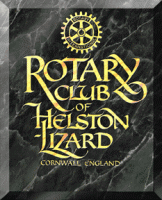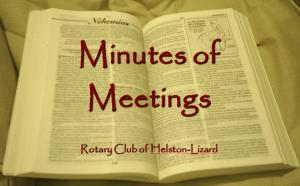Protocol for discussions and debates
Guidelines/protocol for discussion/debate
Guidelines for Protocol during Club Discussions & Debates
1. Introduction
This document has been formulated for guidance, based on the traditional rules of debate, to help make discussions and debates more effective. Where applicable, references are made to relevant parts of the Rotary GB&I Constitution and Standard Club Constitution that will take precedence. This procedure excludes voting on the election of Club Officers, members of Council and membership to the Club, which are covered by Standard Rotary GB&I Club By-Laws.
2. Prior to debate
Proposals committing the club on any matter of public policy or appeals for charitable or other subscriptions must have been considered by Council first (Club By-Law 9)
A quorum comprises one third of (active) membership entitled to vote (By-Law 6, clause 5). Two-thirds is required for matters that amend By-Laws, change the Club's administrative arrangements (e.g. meeting day, time and place) or seek dissolution of the Club (By-Law 6, clause 6).
Members on leave of absence may vote (in writing) by proxy at AGM or any Special or Extraordinary General Meeting of the Club ((By-law 6, clause 6)
The words motion, proposal and resolution are used interchangeably.
3. Time allowed for debate
Resolutions or Proposals will be allocated ten minutes overall to speak for a motion, and ten minutes overall to speak against the motion.
4. Starting the debate
The Chair will begin by calling upon the proposer of the resolution to read out the operative clauses as the first speaker for the motion.
The Chair will then call for a seconder for the motion
If there is no seconder, the motion falls without further discussion.
5. Speaking for the Resolution
Given a seconder, the proposer may then speak in favour of the resolution for up to five minutes. Within this time, the speaker may open the floor to points of information.
If the speaker chooses to accept points of information, short questions may be put to the speaker. Points of view must not be aired during a point of information.
When the proposer has finished speaking, and replying to points of information, he may hand the floor either to another speaker or back to the Chair. If the floor is returned to the Chair, the Chair will ask for further speakers in favour of the motion.
If the floor is handed to another speaker, this speaker may speak for up to three minutes and take points of information, but cannot then pass it on to another delegate: it must be returned to the Chair.
This procedure continues until the time for the motion elapses. If, however, there are no further members wishing to speak for the motion, the debate moves into the time against the motion.
6. Speaking against the Resolution
Time against the motion then proceeds in a similar fashion. When this time has elapsed, a vote on the motion will be called.
7. Speaking at the appropriate time
Members should not attempt to take the floor to speak against the motion during the time used for speaking for the motion, or vice versa. Note that this does not apply to Points of Information, which are questions to speakers both for and/or against the motion.
8. Amendments and Counter-proposals
Amendments are revisions that substantially accept the original proposals or counter-proposal, but make deletions, additions, or alterations to it without defeating its main aim. It is not customary to amend pre-ambulatory clauses, as they are simply an introduction, unless it is a friendly amendment (one which the submitter accepts).
Counter-proposals/motions, are contradictory to the original proposal/motion or a substantial part of it.
A member may submit an amendment or counter-proposal to the chair at any time.
Amendments and counter-proposals must be specific, clearly stating:
- Their purpose, and
- The specific wording and clauses affected by the amendment.
No member may move or second more than one amendment to any proposal
All amendments and counter-proposals the Chair has received by the end of time for the motion will be debated at the beginning of time against.
Amendments and counter-proposals submitted to the Chair, will be read aloud and seconded before being debated.
Amendments and counter-proposals will be allowed one minute for and one minute against. This time is spent in addition to the allocated debating time.
When an amendment to a proposal has been moved and seconded, no further amendments shall be moved until the first amendment has been rejected.
If any amendment has been rejected, other amendments may be moved but they shall not bear the same meaning as amendments already rejected.
If an amendment is carried, it shall take the place of the original proposal, to which further amendments may be made.
9. Right to Reply
The mover or a proposal or amendment which has become the substantive resolution may exercise his right to reply only to answer previous speakers. New matter may not be introduced into the debate.
After this reply, no further debate may take place except Points of Order or information to explain material parts of a speech that are believed to have been misunderstood.
10. Procedure on Resolutions
(Rotary GB&I Constitution, Standing Orders, 9 refer and take precedence)
At any time, members may move:-
- To adjourn the debate or meeting (simple majority);
- That the question be now put (two-thirds majority);
- For the introduction of any business deemed by the chairman to be urgent (simple majority);
- For the variation or suspension of standing orders; (two-thirds majority);
- That the meeting proceeds to the next business (two-thirds majority);
- To receive, adopt, carry out or refer back any report (simple majority);
- To refer business back to Club Council for consideration and report back (simple majority);
No formal resolution as to the above may be moved by any member who has already spoken
Following a vote that the question be now put, resolutions shall be put without further discussion (subject to the right of reply by the proposer).
11. Voting Procedures
Proposals put to the vote shall belong to one of the following categories:
- Original proposal
- Counter-proposal
- Amendments (to proposal or counter-proposal)
- Amendments to amendments
Voting shall normally be by show of hands or, at the discretion of Chairman by ballot
The Chairman shall have a second or casting vote in the event of votes being equal.
12. Responsibilities of Members
Each member has a duty to:
- Address the chair
- Speak only on the resolution under discussion
- Speak not more than once on any proposal or amendment
- Respect the decision of the Chair at all times;
- Obtain the floor before speaking;
- Stand before speaking;
- Yield the floor when required to do so by the Chair;
- Be courteous at all times.
13. Glossary of Terms
A Point of Order is a question that may be raised by members at any time as to the application or interpretation of these standing orders. The ruling of the Chairman is conclusive.
A Point of Information is a short factual statements or question seeking facts or explanation, excluding points of view, that may be put to the speaker at any time through the Chairman. Points of information may be answered or ignored. It is generally a good idea to answer points of information.
Download a PDF version of above

